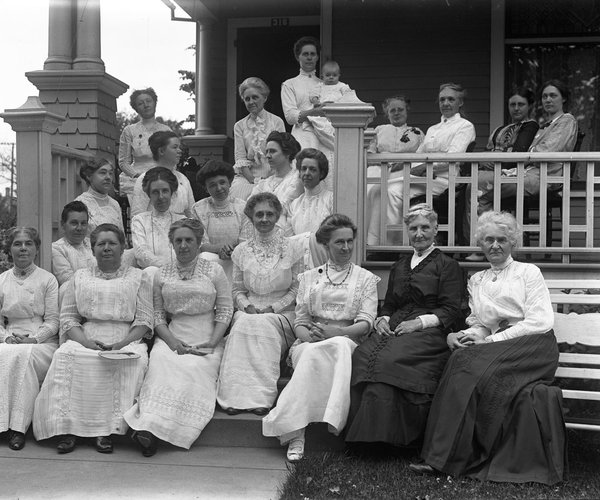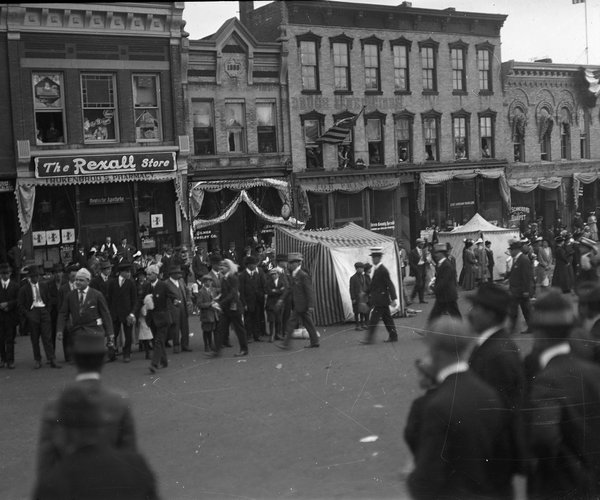I started my journey into local history by first researching and writing about my ancestors. As I write these columns, I find myself wanting to learn more about the persons behind the news. Today we will learn more about Roger Gettings, the man whose son sold his property by dividing it into lots and offering them in a lottery system.
Roger Gettings was born in Ireland in 1831 and immigrated in 1848. He married Bridget Byrne in Philadelphia in April 1854. They moved to Monroe the following month where he was one of the city’s pioneer stone masons. Little is know of his earliest days here. The 1860 census lists them with three children and $300 in real estate and $100 in personal property.
Gettings’ obituary said, “Along about war time he engaged in the butchering business and a meat market on Jackson St. was successfully conducted for a number of years.” The 1870 census verified that he was a butcher, now with six children. His real estate was valued at $1,600 and personal property at $200.
The first article found in the Sentinel about him was dated June 10, 1874; it said that he had put a new front on his small wooden building on 16th Avenue as well as making other improvements. Four years later in April he had opened a meat market on the south side of the square, two doors west of Bolender & Co. “Rodger is deserving of customers in his business.” He carried “all kinds of fresh meats in their seasons and salt meat at all times.” In December his oldest son, Mike, 22, who carved meat for his dad’s customers, “cut the instep of one of his feet with an ax.” Dr. Bradshaw dressed the wound and expected it to be all right “if Mike can keep quiet a few days.”
It was announced in April that Gettings was about to make an expensive improvement in his market “for keeping meat cool in summer without putting it on ice.” Roger Gettings & Son’s Meat Market installed a Birdsell refrigerator in their market, which kept “large quantities of meat in the hottest weather without any inconvenience, and what is more the meat is kept dry.” A system of ventilation and drainage kept “a cool and perfect atmosphere.”


Gettings were looking to purchase “some first-class butcher’s stock, fat cows, and heifers” in January 1880 and were willing to pay “ the highest market price in cash.” This must have been common as in June 1881 they had “just purchased several as fine fat steers for their market as were ever driven to Monroe.”
Roger left for Balamiece, Tallaght, Dublin Co., Ireland on June 20, 1881, expecting to be gone until September 1. Plans changed while there and he then expected to leave on August 17. He was forced to delay his return for several days because he was not able “to secure a state room on the line of steamers he took passage out-going.” He had purchased his return ticket in New York, but realized it was best to purchase a ticket one way so he could take any line home. He finally returned home on September 16, doing him good to be back under the “Stars and Stripes“ again. “He had a good time on the ‘old sod.’”
The 1880 census shows the family of nine living on the northwest corner of 11th Avenue and 15th Street where they owned 12 lots. These lots were sold for $1,450 in September 1882 with possession taking place on October 1. At the same time, they purchased the 14 acres that eventually became the Gettings Addition, mentioned in a previous column.
A startling event was reported on December 2, 1885. “A lusty Granger, who lives west of the city, named Carroll, presented himself at Roger Gettings meat market on Monday afternoon, and took possession bodily. He was not satisfied with ordering the proprietor about and giving practical illustrations of what he considered his ability to run a butcher shop, but he made things painfully uncertain about the shop, in fact, painted it red for a few moments. He smashed things. The sausage grinder suffered dismantlement, and permanent damage to the extent of about half its cost. Finally sheriff Morse came to the rescue, and with the assistance of John Baird, the crazy Granger was locked in the county jail to sober off. The whiskey he drank, made him mad. It was not drunkenness; it was frenzy from the effects of bad whiskey. Where did he get it?”
By May 1887 John Chambers and Bert Chandler had opened up a new stone quarry on the Roger Gettings farm in the north part of the city. There were “good prospects” there.
Roger Gettings & Son had removed their meat market to the central store in the new Syndicate Block in February 1889. “It is but simple truth to say it is the most commodious, and elegant meat market ever open to the public in Green County, or in the state. Everything fresh and new. Elegant, large refrigerator and cold storage, floors, and furniture neat as wax. It is worth a visit just to see for yourself. Gettings will keep a full variety of fresh and cured meat, fresh fish, oysters, sausages, etc. They hope their old customers will follow them and new ones will call to see what sort of a meat market can be kept in Monroe.”
The father and son must have worked well together and been open to new ideas. They used their water motor in January 1890 to run their meat chopper. They took a suggestion from their customers and started to operate a delivery wagon in May 1896 so customers could leave orders at the market or call 39-4 on the telephone to “have them filled and delivered promptly to any part of the city without extra charge.”
Roger’s wife passed away in November 1898. Roger started having serious bronchial trouble in August 1901, passing away on December 30. Their son, Michael, continued to operate the meat market until 1914.
— Matt Figi is a Monroe resident and a local historian. His column will appear periodically on Saturdays in the Times. He can be reached at mfigi48@tds.net or at 608-325-6503.





